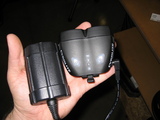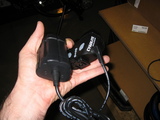LED Bicycle HeadlightsWritten October 30, 2006 I want to get a new headlight for my bicycle. I have a years-old NiteRider Night Owl, the battery of which is starting to get weak. After pricing replacement batteries (yikes!) I started looking new systems. Specifically, LED and HID systems. After a bit of research, I pretty much ruled out HID as being too expensive, and unsuitable for road use (ie, impolite to oncoming motorists). I would consider HID, but I really think that for my purposes (ie, moderate budget commuting use), it's overkill. This review is based on that experience. I haven't tried mounting either of these lights to a bike, and didn't have appropriate equipment or conditions to take pictures of beam patterns. This is, therefore, a necessarily limited, off the cuff review. NiteRider MiNewtThe MiNewt (what a ridiculous name) was my first thought. I like my current NiteRider light, so NR was the first place I looked. The beam pattern is relatively smooth, with a roughly circular hotspot, then a dimmer corona. The light is very faintly purplish, but only in comparison to other whiter lights. It wouldn't be a noticeable tint once you were riding.
The light uses a funky power connector which is presumably proprietary to NiteRider. It looked like it wouldn't suffer from accidentally popping out. The power cord is very short (about 9" long), and obviously the battery is meant to be attached to the stem, rather than the bike's frame. The light's mount is via a glorified rubber band. I'm sure it's functional, and quite secure, but those things are a pain to deal with, and I would hate to have to take it off every day (which I do pretty much any time I'm parking the bike outside my garage). It looked like the battery mounted with a velcro strap, but I didn't see the strap in my brief time with the light. I was able to take both lights out in the dark, where I discovered that there was an office building across the street, perfect for long-distance visibility tests. I shone each light on the windows straight across from me, and was able to see how visible they were in the plain glass (which, by its partial reflectivity, simulates a real-world-like situation). The MiNewt was visible when it was aimed straight at the window, but when shined even 10° off to the side, became quite difficult to see. I decided against the MiNewt for a number of reasons. Probably highest on the list were the off-axis (lack of) light, and the funny power connector. A close runner-up was the rubber-band mounting system, which would drive me batty in short order. For the price, I was impressed with the technology available, but it didn't really align closely enough with what I wanted. Cygolite Dualcross The Dualcross has two LEDs, and two lenses. It also has two buttons, and four status LEDs on top. The battery is larger, also in a hard case like the MiNewt. The light head mounts by a slide-in clip, making it trivial to remove and reinstall. I didn't get a chance to see the handlebar mount, but it's my hope that it will allow some up-and-down and side-to-side movement. Operating the Dualcross was more complex than the MiNewt, but it also has nearly 3x more modes. After toying with it for 5 minutes, I'd basically sussed out how it worked. Pressing either button quickly from the off setting would bring it into "steady" mode. Pressing either button briefly after that causes it to go up or down in brightness. There are four brightness levels. So pressing the left button increases brightness (let's say), while the right button decreases brightness. Both buttons wrap around when they hit the border, so it'll go dim, brighter, brighter, full bright, dim. As each brightness is selected, the status LEDs light up, bar-graph style (dim shows the lowest LED on, full bright shows all four on, one step down from full shows 3 LEDs, etc.). They lit up green for me, but I got the impression they change in some way to indicate battery condition -- changing color, or flashing, or something, to show a low battery. From any mode, holding down either button seemed to turn off power. Interestingly, there's no way to turn on just one of the lamps. All the different modes have both lamps on. Turning off one of the lamps would have seemed like an obvious way to save power, but evidently they decided to do some PWM dimming on both rather than wire them separately. That's probably positive, from a visibility standpoint, as having both lights on makes the visual target larger. The beam on the Dualcross is a slightly splotchy horizontal figure-8, like an infinity symbol, with a dimmer corona. As I'd expected, the Dualcross throws twice as much light as the MiNewt, although it takes advantage of that extra light to make a bigger hotspot, rather than a small, brighter hotspot. I don't know that I'd go freaking out about any patented dual beam crossing systems if I were Cygolite, but the beam did look usefully large. The beam color is very white, without any visible tint when compared with my HDS EDC flashlight (which has a very nice white tint). In the office-window test, the Dualcross was considerably more visible than the MiNewt, both straight-on, and off-axis. I believe the better off-axis performance is largely due to the much larger reflector and lens area compared to the MiNewt. There's no question, for my purposes, that the Cygolite is the better choice. It's more visible (most of my goal is to make myself easier to see); it's easier to remove; it's got theoretically better runtime (4 hours on high, vs. 3 hours on the MiNewt); it's got a standard power connector; the 200 version is a comparable price to the MiNewt. Both lights seem to come highly recommended, after reading through reviews and comments on bicycle forums. Both felt solid to me, and I wouldn't have any qualms about buying either one, from a build-quality standpoint. Don't let my decision necessarily affect your own -- if you want a tiny, unobtrusive blowtorch for your fixie, the MiNewt's your man. For me, the Dualcross is the correct choice. Created by Ian Johnston. Questions? Please mail me at reaper at obairlann dot net. |





